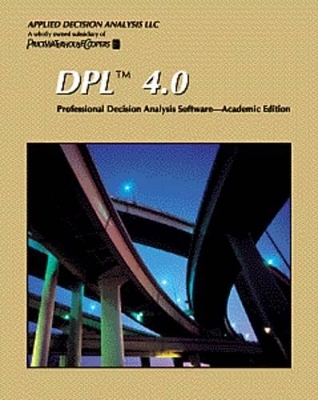
DPL 4.0
Brooks/Cole
978-0-534-35368-1 (ISBN)
- Titel ist leider vergriffen;
keine Neuauflage - Artikel merken
Now available in Version 4.0 for Microsoft Windows 95/98, this software package with its accompanying handbook teaches students to use DPL, the popular software that is simple enough for beginning students to learn, and yet powerful enough for complex decision analysis. The academic version of DPL offers all the capability of the professional version, minus the advanced run-time optimization features that students typically don’t need.
1. OVERVIEW OF DECISION ANALYSIS
What is Decision Analysis? / Phase I: Framing / Phase II: Building a Model and Gathering Data / Phase III: Analysis and Evaluation / Phase IV: Making the Decision
2. SYSTEM OVERVIEW
DPL Windows / Project Manager / The Model Window / Running an Analysis / Endpoint Database / Saving / Importing and Exporting Elements of a DPL Project / Printing / Session Log / Options / On-Line Help
3. DECISION ANALYSIS TUTORIAL
Introduction / The Spreadsheet / Welcome to DPL! / The DPL Model / Modeling Decisions and Strategy Tables / Sensitivity Analysis / Probabilistic Modeling / Analyzing the DPL Model / Further Analysis / Wrapping Up
4. DECISIONS AND STRATEGY TABLES
What is a Decision? / Tutorial: Decisions / Strategy Tables / Tutorial: Strategy Tables
5. CHANCE EVENTS
What is a Chance Event? / Tutorial: Chance Events
6. VALUES, GET/PAY EXTENSIONS, AND OBJECT FUNCTIONS
Modeling with Value Nodes / Modeling with Get/Pay Expressions / Modeling with an Objective Function / Tutorial: Values, Get/Pay Expressions, and Objective Functions
7. MULTIPLE ATTRIBUTE MODELS
How to Use Model Multiple Attributes / Using a Constraint Function / Tutorial: Modeling Decisions with Multiple Objectives
8. TIMING AND STRUCTURE
Too Many Trees? / Timing / Structure / Tutorial / Tutorial: Timing and Structure
9. SPREADSHEETS
Spreadsheet Links / Tutorial: Spreadsheets
10. EVALUATION METHODS
How DPL Analyzes a Model / How DPL Calculates Expected Value / Tutorial: Calculating the Expected Value of a Model / How Can DPL Run so Fast? / How DPL Runs a Simulation / Tutorial: Simulation / How DPL Calculates Multiple Attribute Models / Tutorial: Analyzing Models with Multiple Objectives / Modeling Risk Attitude / Tutorial: Risk Tolerance/Certain Equivalent
11. POLICY TREES
How DPL Generates Policy Trees / Reading a Policy Tree / Tutorial: Policy Tree
12. RISK PROFILES
How DPL Generates Risk Profiles / Reading Risk Profiles / Tutorial: Risk Profile Chart / Using Reduction to Convert a Risk Profile into a Chance Event / Tutorial: Reduction
13. EXPECTED VALUE TORNADO DIAGRAMS
How DPL Generates an Expected Value Tornado Diagram / Reading an Expected Value Tornado Diagram / Tutorial: Expected Value Tornado Diagrams
14. DPL PROGRAMS
What is a DPL Program? / Overview of DPL Programs / Defining Components in the Definition Section / Defining Event Sequences / Advanced Techniques for Programs / Tutorial: Converting a Model to a Program
15. POLICY SUMMARIES AND COMPARISONS
How DPL Generates Policy Summaries and Comparisons / Reading a Policy Summary / Reading a Policy Comparison / Tutorial: Policy Summary and Comparison
16. VALUE OF PERFECT INFORMATION AND CONTROL
How DPL Calculates the Value of Perfect Information and Control / Reading a Value of Information and Control Graph / Tutorial: Value of Perfect Information and Control
17. RAINBOW DIAGRAMS
How DPL Generates a Rainbow Diagram / Reading a Rainbow Diagram / Tutorial: Rainbow Diagrams
18. BASE CASE TORNADO DIAGRAMS
How DPL Generates a Base Case Tornado Diagram / Reading a Base Case Tornado Diagram / What Should the Base Case Be? / Including Constants in a Base Case Tornado Diagram / Tutorial: Base Case Tornado Diagram
19. EVENT TORNADO DIAGRAMS
How DPL Generates a Deterministic Event Tornado Diagram / Reading a Deterministic Event Tornado Diagram / How DPL Generates a Probabilistic Event Tornado Diagram / Reading a Probabilistic Event Tornado Diagram / When Should You Use a Probabilistic Tornado Diagram? / Tutorial: Event Tornado Diagram / INDEX / GLOSSARY / BIBLIOGRAPHY
| Verlagsort | CA |
|---|---|
| Sprache | englisch |
| Maße | 188 x 233 mm |
| Gewicht | 794 g |
| Themenwelt | Mathematik / Informatik ► Mathematik ► Analysis |
| Mathematik / Informatik ► Mathematik ► Finanz- / Wirtschaftsmathematik | |
| Wirtschaft ► Betriebswirtschaft / Management ► Unternehmensführung / Management | |
| ISBN-10 | 0-534-35368-1 / 0534353681 |
| ISBN-13 | 978-0-534-35368-1 / 9780534353681 |
| Zustand | Neuware |
| Haben Sie eine Frage zum Produkt? |
aus dem Bereich


